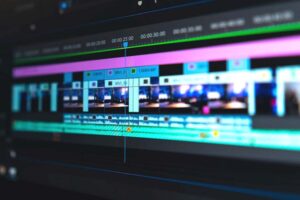
Post-production technology has transformed, ushering in a new era of filmmaking. Because of the seamless integration of digital effects and CGI and the transformative potential of non-linear editing technology, filmmakers now have unprecedented autonomy and creativity. Post-production tools have made filmmaking easier while also expanding storytelling and visual aesthetics. With greater visual effects and immersive sound design, directors may create captivating films that transport viewers to strange regions.
The evolution of post-production tools and techniques
Technology developments have ushered in a new era of post-production, altering the process by which filmmakers realize their dreams. The equipment and methods used in post-production have undergone a remarkable shift with the introduction of strong software and cutting-edge hardware. An AI video editor is one such development; it is a tool that employs artificial intelligence to enhance and automate the editing process. Filmmakers today have unparalleled flexibility and creativity compared to the early days of labor-intensive manual editing and the seamless integration of digital effects and CGI. The development of post-production technologies has opened up a world of possibilities, stretching the limits of storytelling and aesthetically pleasing design. One might ask, “what is an AI video editor?” It is a technology that has significantly shortened the filming process.
Enhancing visual effects: from practical to digital
The realm of visual effects has undergone a remarkable transformation, propelled by technological advancements. From practical effects achieved through physical props and makeup to the seamless integration of digital wizardry, the possibilities for creating awe-inspiring visuals have expanded exponentially. Filmmakers now have the ability to transport audiences to fantastical worlds, breathe life into mythical creatures, and recreate historical events with astonishing realism. The marriage of practical and digital effects has elevated the visual storytelling experience, captivating viewers and immersing them in a realm where the line between reality and imagination becomes beautifully blurred.
Streamlining the editing process: non-linear editing systems
The advent of non-linear editing systems has revolutionized the editing process, offering filmmakers unprecedented flexibility and efficiency. Gone are the days of physically cutting and splicing film reels, as digital technology now allows for seamless manipulation of footage. With the ability to instantly access and rearrange clips, add visual effects, and fine-tune audio, editors can bring their creative visions to fruition with greater precision. Non-linear editing systems have accelerated the post-production workflow and empowered filmmakers to experiment, iterate, and refine their storytelling choices, ultimately enhancing the overall cinematic experience.
Sound design and mixing: immersive audio experiences
Sound design and mixing are critical to creating immersive audio experiences that captivate listeners. Technology has dramatically increased the depth and richness of cinematic sound. By properly inserting audio pieces and controlling sound effects and ambient noise, filmmakers may create rich, multi-dimensional soundscapes that engage viewers in the story. Sound design and mixing advancements have improved films’ cinematic experience and emotional impact, making them truly immersive.
The advancement of post-production equipment and procedures has given filmmakers unprecedented power and ingenuity. Filmmakers can now create realistic and interesting audio experiences because of visual effects, editing, and sound design advancements. This incredible advancement has eased filmmaking while expanding the storyline and visual aesthetics. As technology progresses, post-production will continue improving the cinematic experience for filmmakers and audiences.




